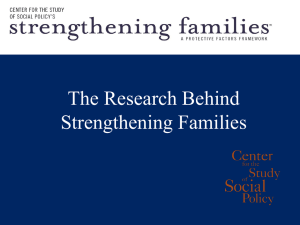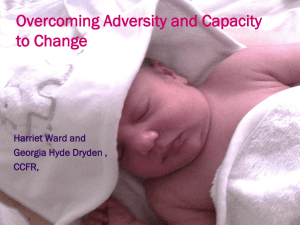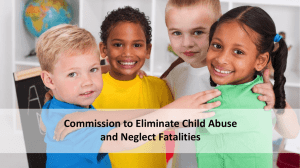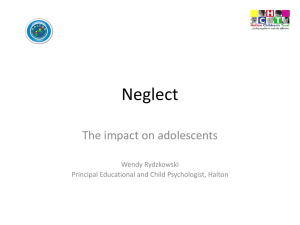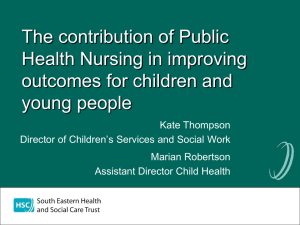Child welfare systems in the US were not designed to cope with this
advertisement
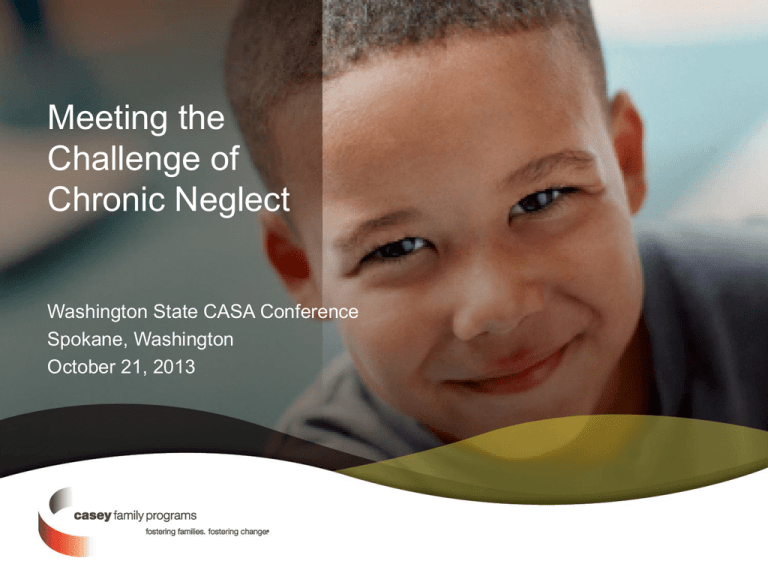
Meeting the Challenge of Chronic Neglect Washington State CASA Conference Spokane, Washington October 21, 2013 Chronic neglect and chronic maltreatment (i.e., the combination of chronic neglect with physical abuse and/ or sexual abuse) is arguably the most difficult challenge facing public child welfare systems in the U.S. Child welfare systems in the U.S. were not designed to cope with this challenge NCANDS Statistics In recent NCANDS reports, almost 80% of substantiated victims were found to be neglected; and in some states, 90 to 100% of children in substantiated cases were neglected. Two child welfare scholars, Jane Waldfogel and Isabel Wolock, have provided strong evidence that high child poverty rates in English speaking countries lead to child protection systems in which neglect reports far outnumber reports of other types of child maltreatment. POC Study A 2009 Partners for Our Children (POC) study found that almost half of families with open child welfare cases had annual incomes of less than $10,000 per year; and one-fifth of families had no source of income and were not living with a person making more than $20,000 per year. Substance Abuse Mental Health Poverty Trauma/Violence RECIPE FOR CHRONIC NEGLECT AND CHRONIC MALTREATMENT Combine a high child poverty rate and a high rate of severe long term poverty ADD Extreme Income Inequality MIX WITH Early onset mood disorders (depression, PTSD) often resulting from early trauma TOP OFF WITH Substance abuse and/or family violence Other factors may contribute to this recipe • • • • Porous social safety net High rate of poor single parent families Racial bias Ambivalent confused social attitudes regarding neglect • Extreme cognitive impairments of parents Chronic neglect and chronic maltreatment are an extreme form of family breakdown. The legal scholar and child welfare expert, Michael Wald, has estimated that about one-fifth of low income families engage in marginal to poor parenting practices. In far less affluent societies, family breakdown may result in large numbers of young school age children living on the streets. Fortunately, not all neglect is chronic neglect • • • • Situational Neglect Sporadic Neglect Chronic Neglect Chronic Maltreatment The type of child abuse and neglect in the initial report is not a reliable predictor of types of subsequent reports (Loman, 2006) There are two main dynamics in chronic neglect and chronic maltreatment: (a) the erosion or collapse of social norms around parenting and (b) the loss of self efficacy associated with depression and demoralization. Depression and Demoralization Severe depression has a strong cognitive element, i.e., hopelessness/helplessness, which I refer to as demoralization. Indicators of Demoralization • • • • • • • Poor self care Lack of concern with physical environment Apathy in the face of threat Cannot “regroup” in the face of adversity Accepts demeaning behavior and attributions Unresponsive to offers of help Hopeless/helpless Factors Which Sustain Morale in Difficult Circumstances • • • • • • • • • • • • Past success with overcoming adversity Strong sense of identity Good health Affiliation with a religious community Social support/encouragement Hope A sense of meaning and purpose Taking pleasure in small things An ability to ask for help and give help Strong self-esteem Anger Material resources The Practice Challenge What does it take to engage hopeless/helpless parents in services or in therapeutic activities? Young children in chronically neglecting and chronically maltreating families may be in physical danger from time to time; young children are more likely to die in neglect related “accidents” than from physical abuse. In practice, it is often difficult for professionals to agree whether a child’s death was neglect related or solely an accident. Nevertheless, the main harms to children resulting from chronic neglect and chronic maltreatment are emotional and developmental; and these harms are cumulative. Blank face video Chronic Neglect Makes Children More Vulnerable Severe and chronic neglect in early childhood compromises young children’s immune systems. Dysregulation Physiological dysregulation lays the foundation for emotional dysregulation. Serve and Response Normal brain development in young children depends on predictable “serve and response” interactions between babies and toddlers and their caregivers. Effects of chronic neglect/chronic maltreatment on children’s development, emotional well being and mental health 1. 2. 3. 4. 5. 6. 7. 8. Compromises immune system Attachment Cognitive development/language delay Affect regulation Social self confidence, social competence Perseverance in problem solving Empathy/conscience Conduct disorders/delinquency Young children living in chronically neglecting or chronically maltreating families need to be in high quality or therapeutic child care programs. Effective interventions with many of these families will be lengthy and expensive; child welfare policy and practice should emphasize prevention and early intervention. A Design Change Public agencies, in collaboration with other state and community agencies, need to develop a structured approach to the assessment of multi – problem families. Family Support Teams Ideally, chronically neglecting and chronically maltreating families would be served by 4 to 5 person family support teams that include substance abuse, mental health, child welfare and a parent advocate. Four Main Types of Services for Neglecting Families • Poverty-related services • Parenting programs and other programs designed to teach skills • Substance abuse and/or mental health treatment and DV services • Long term case management services for chronically, mentally ill or developmentally disabled parents Sequencing? There is no research based right answer to the question of how best to sequence services to chronically neglecting multi-problem families. However, there is general agreement that complex service plans must be sequenced to be effective. Promising Practices In the past 10-15 years, several promising practices have been developed for working with substance abusing parents, many of whom have had their children removed due to neglect. These practices include: use of family treatment drug courts, peer mentors, parent advocates (e.g., PCAP), Pregnant and Parenting Women treatment programs and transitional housing programs. An Economic Future Some fraction of parents in recovery can benefit from educational or job training programs. Community Empowerment Community empowerment programs have been used to lower rates of neglect reports and rates of out-of-home care. These programs utilize a combination of social norming and comprehensive family supports.

